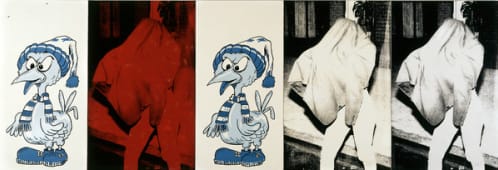Julia Wachtel Procession, 1989 Oil, flashe, lacquer ink on canvas 147 x 419 cm 58 x 165 inches Emerging with the Pictures Generation artists in the early 1980s in New York, Wachtel has worked with juxtaposition and the visual language of mass culture for the last 30 years. Her oil, acrylic and silkscreen on canvas paintings enter into a visual language game wherein appropriated imagery is illustrated, simulated, replicated, altered and parodied. For her first exhibition at Vilma Gold, Wachtel brings together works from the 80s and 90s alongside recent painting and new poster work. At the beginning of her career, Wachtel produced a series of poster and marker pen wall-based works that would inaugurate one of the artists’s central concerns: how subjectivity — i.e., the psychology of the individual — is constructed, reconstructed, or even fragmented in relation to the panoply of images which saturate our lives. In acts of wantonly literal appropriation, Wachtel utilised commercially available posters of movie stars, pin-up girls, political figures, and pop music icons, among other related images in a presentational strategy based upon repetition and juxtaposition. In 1983, Wachtel began to shift the focus of her method of appropriation towards another realm of mass culture. Cartoon figures selected from the domain of commercial greeting cards began to assume a central role in Wachtel’s vocabulary. By recycling cartoon characters, Wachtel managed to underscore their latent function as symbols of a particular representation of the human condition within the context of late-capitalist society. Through their exaggerated expressions of pleasure, pain, anger, and confusion, among other emotional states, these characters became indices for particular psychological condi¬tions. It is almost as if the cartoon characters, whose actual function is primarily entertainment-oriented, became cyphers designed to counter repression through comic means. With the ‘Landscape series’, begun in 1989, Wachtel inserted these cartoon characters into the readymade lexicon of mainstream magazine and newspaper photographic images documenting the contemporary socio-political landscape of the time. The cartoon figures were utilized as symbolic commentators on the religious, cultural, ideological, and political issues that were inscribed on the adjoining silk-screened canvases. The ensuing juxtapositions produce a hybrid “landscape” wherein the cartoon characters underscore the position of Wachtel (and by extension the viewer), who equivocates between imposing moral or didactic political/ideological critique and assuming a position of ambivalence. Crucially Wachtel chose subject matter that elicited an emotional response. Her cartoons are choruses of stylised, extreme emotion and although the work can be analysed in light of the critique of the media, the strength and, moreover, durability of Wachtel’s work rests on her interest in human emotion.

